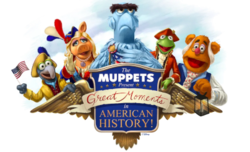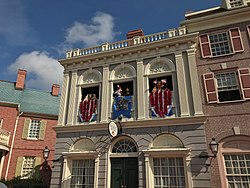|
The Muppets Present...Great Moments in American History
The Muppets Present ... Great Moments in American History was a live show located in the Liberty Square area at the Magic Kingdom, performed daily and featured the Muppets presenting abridged accounts of notable milestones from the Colonial era of American history and its majority unfolded from the second-story windows of the Heritage House, adjacent to the Hall of Presidents attraction.[2] The show premiered on October 2, 2016[3] and went on a brief hiatus on October 5, 2019, before temporarily returning three months later for a brief holiday run from December 23 to 31, 2019[4][5] before closing on February 17, 2020 due to the COVID-19 pandemic closure. This was the last Muppets production to feature Steve Whitmire before his dismissal from the role of Kermit and other characters sometime in the same month of October 2016. The Muppets are physically performed live in the show by the park's in-house puppeteers in synchronization to a pre-recorded dialogue track. The Muppets Studio and Muppet performers Steve Whitmire, Eric Jacobson, and Dave Goelz provided consultation, as well as recording the voices for their respective characters.[1] ShowKermit the Frog, Miss Piggy, Fozzie Bear, Gonzo, and Sam Eagle are featured in the show. A live cast member portrays James "J.J." Jefferson, the town crier who engages the audience in the "Declaration of Independence" sketch.[2][6][7] Each show performance features one of the following sketches:[8]
Voice cast
DevelopmentThe show's development started in the spring of 2014, following the release of Muppets Most Wanted. Originally, the show was only going to feature Sam Eagle interacting with guests and telling them about American history. However, it was later decided that, to make the show more entertaining, Kermit, Miss Piggy, Fozzie Bear, and Gonzo would be added in.[10] Jim Lewis was asked to provide consultation on the show's scripts. Due to the distance between guests and the Muppet characters, the puppets are made 5% larger than the size traditionally used for film and television.[10] References
|
||||||||||||||||||||||||||||||||

